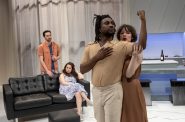MSO Is Great But Audience Could Be Better
Orchestra scores with three romantic works right in its wheel house.
On a weekend that turned from chilly to drearily rainy, the Milwaukee Symphony Orchestra, with guest conductor Asher Fisch and mezzo-soprano Michelle DeYoung, warmed its audience with the passionate music of three distinctly different examples from the Romantic era. The orchestral repertoire of this period is right in the middle of the MSO’s wheelhouse, and the program showed off the orchestra’s longstanding tonal brilliance along with very impressive ensemble playing.
The concert opened with Robert Schumann’s Symphony No. 2 in C major, Opus 61. This symphonic work, classically structured and elegant with big romantic gestures, begins with a stately opening theme marked Sostenuto assai. Sonorous brass began the solemn hymn-like fanfare, and the strings added counterpoint reminiscent of Bach. After a few last statements from the brass and timpani, the strings deftly acceleratedinto the Allegro ma non troppo, skipping and running with a happiness that belied the severedepression that plagued Schumann while working on this composition. Much ink has been spilled about Schumann’s mental state at the time, but the end result suggests the triumph of art over emotional adversity.
The Scherzo: Allegro vivace second movement—an audition excerpt familiar to anyone looking to land a spot in a first violin section—is a blistering run around the fingerboard in one hand with the bow trying to start a fire in the other. Schumann’s scherzo is written in a basic minuet trio form: the first, a conversation among woodwind choir, horns, and strings, which the MSO played with impeccable intonation, boisterous energy, and warmth of sound; the second, a nod again to the counterpoint of Bach with the woodwinds accompanied by the violas. The return to the scherzo showed off the first violin section, which played the coda with blazing virtuosity.
After intermission, the orchestra turned to Alban Berg’s Seven Early Songs. These songs, written between 1906 and 1908, are from more than 100 he composed for voice and piano. Twenty years later, Berg’s wife, Helene, encouraged him to take another look at that substantial catalog of songs. He orchestrated these seven for voice and orchestra. Berg’s early songs are late Romantic gems that should be a reasonable listening challenge to the regular symphony goer. They are lushly orchestrated, favoring the musical influences of Debussy, Brahms, and Strauss and set to texts by well-known poets such as Hauptmann, Lenau, and Rilke.
Unfortunately, a few people around me were restless and openly condescending in their remarks about the music during the performance. Because the MSO exists to bring myriad musical experiences to its audience, not just familiar favorites, listeners had the opportunity to hear a wonderful artist in a less-well-known work. DeYoung sang with such gorgeous tone, lyrical intensity, and a full palette of colors and dynamics that even if the Berg sounded new to some ears, there was plenty on display to be pleased by. Fisch, perhaps unaware of the acoustical weaknesses of Uihlein Hall, didn’t do enough to finesse the dynamics in the orchestra. The MSO is a virtuoso orchestra that accompanies with aplomb; a bit more attention from the podium, coupled with a little less opining in the audience, and we wouldn’t have missed a single note of Ms. DeYoung’s ravishing performance. When a new piece of music is before you as a listener, do as Hauptmann’s text suggests in Berg’s first song Nacht:
O listen! Pay heed!
A broad land of wonder has opened up.
Death and Transfiguration is one of Richard Strauss’s early efforts, but like most of his work, his compositional style and orchestration techniques are spectacular. His tone poems are always favorites of any orchestra because they are showpieces for both individual instruments and the orchestra in its entirety. In this transcendental work, Strauss is able to describe, in music, everything from a weakly fluttering heart to bone-rattling death throes to the unequalled beauty of transfiguration; putting an orchestral voice to nearly every human experience. Maestro Fisch seemed much more at home with the Strauss, as he did a fine job shaping the pace, colors, and dynamics while achieving precise ensemble entrances for an emotionally satisfying experience. Concertmaster Frank Almond, timpanist Dean Borghesani, and the mighty forces of the horns and brasses were particularly impressive.
Review
-
The Life Story of Gene Wilder
 Apr 8th, 2024 by Dominique Paul Noth
Apr 8th, 2024 by Dominique Paul Noth
-
‘L’Appartement’ Is a Mind-Bending Comedy
 Mar 25th, 2024 by Dominique Paul Noth
Mar 25th, 2024 by Dominique Paul Noth
-
Highlands Café Is Easy to Love
 Mar 15th, 2024 by Cari Taylor-Carlson
Mar 15th, 2024 by Cari Taylor-Carlson
















